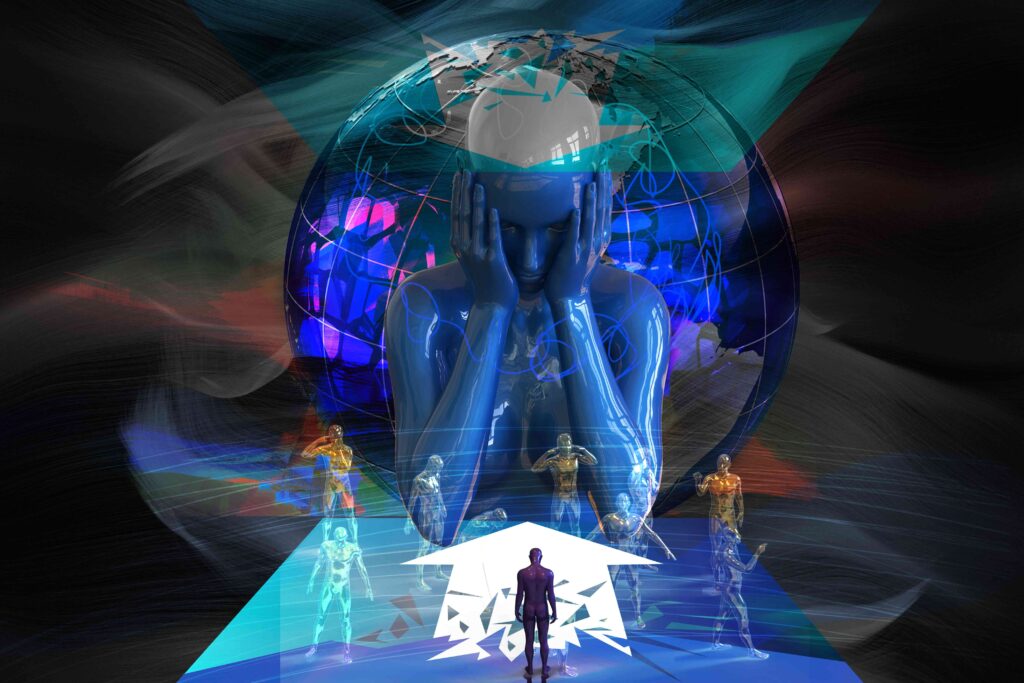A Taxonomy of Chaos
Jan. 13, 2023. 8 mins. read.
18 Interactions
Chaos is the new norm! In this article, Jamais outlines his taxonomy of chaos, which is Brittle; Anxious; Nonlinear; and Incomprehensible.
Being a futurist is quite a bit like being a historian. History isn’t just a listing of events, it’s a discipline that seeks to figure out why this or that happened, what led that direction, and what choices we had along the way. The same thing can be said for foresight work — the goal isn’t to list future events, it’s to get a better understanding of why we’re getting various outcomes, and how our choices can lead us in very different directions. I think of futurism as Anticipatory History.
The success of this process depends upon our ability to spot patterns; as Theodor Reik said, “It has been said that history repeats itself. This is perhaps not quite correct; it merely rhymes.” But what happens when the rhyme scheme breaks? That is, what happens when our expectations about patterns start to fail?
I’ve been working as a futurist for over 25 years, so I’ve spent quite a bit of time observing (and learning from) global patterns. About five years ago, I started to get a sense that patterns weren’t repeating (or rhyming) as readily, that big global systems that had once been fairly consistent had become far less so. Looking back, I suspect that the primary catalyst was the accelerating impact of global climate disruption.
Big economic, political, environmental, technological, even sociocultural systems seemed like they were starting to fail, or at least become much less reliable. I wasn’t alone in these observations.
In 2018, I started working on a framework for understanding the scale of what we’re facing as once seemingly-reliable global systems started to break down. So many of the people I spoke with over the past half-decade had started to express great surprise and confusion about what was going on around the world; it quickly became apparent that this wasn’t just the standard “the future is an unknown” that we all live with, it was an increasingly desperate sense that things we thought we understood were spinning wildly out of control. We couldn’t as reliably make reasonable judgments about what was to come in the weeks and months ahead. Systems that appeared strong were suddenly on the verge of collapse; processes that were becoming increasingly critical to our daily lives were becoming less and less understandable.
Creating a framework like this wasn’t just a random idea; I was trying to bring a conceptual tool already in the foresight analyst’s kit into the 21st century. The world of strategic consulting had long relied on a basic framework to offer language and structure to a changing world. It was the “VUCA” model, which was invented in the late 1980s at the US Army War College and spreading quickly throughout the world of consulting. VUCA is an acronym comprising four descriptive terms: Volatile; Uncertain; Complex; and Ambiguous. For a world moving out of the Cold War era and into the Internet era, these terms felt right. They perfectly captured the kinds of disruptions that were starting to happen more often, especially as the global war on terror fired up.
But the world has rocketed past merely being “uncertain” or “volatile.” At this point, VUCA no longer captures disruptions to the norm, it is the norm. But if a VUCA world is all around us all the time, the term has lost its utility as a way of labeling discontinuities in how our world functions. Something new was needed.
In late 2018, I presented the “BANI” framework for the first time. BANI parallels VUCA, in that it’s a basic acronym for a set of descriptive terms. In this case, however, the terms are as subtle as a brick. BANI comes from: Brittle; Anxious; Nonlinear; and Incomprehensible. These four concepts let us articulate the ways in which the world seems to be falling apart. It’s a taxonomy of chaos.

The quick summary:
B in BANI is for Brittle. Systems that are brittle can appear strong, even work well, until they hit a stress level that causes collapse. Brittle does not bend, it breaks. Very often the breaking point isn’t visible to most people in advance, and comes as a surprise. Sometimes this is because the weaknesses are hidden or camouflaged; sometimes this is because the stress that causes the break is external and unexpected. The example I like to use is guano, fecal matter from birds and bats. In the 19th century, its use as a fertilizer gave the world its first taste of an agricultural revolution. It was so important that countries fought wars over ownership of guano-covered islands. And in a few short years late in the century, that all disappeared after the development of the Haber-Bosch process for making artificial fertilizer. Something that was absolutely critical became worthless seemingly overnight.
Brittle chaos is sudden, surprising, and hard to ignore.
A is for Anxious (or Anxiety-inducing). Systems that trigger anxiety are those that pose dilemmas or problems without useful solutions, or include irreversible choices that have unexpectedly bad outcomes. Anxious systems make trust difficult, even impossible. Things that had been well-understood suddenly seem alien or false. My usual example of an anxiety-inducing system is malinformation, the term that encompasses intentional misinformation, errors, insufficient information, and confusion. Noise in the signal. The last half-decade has been full of this, and we’ve seen some especially powerful uses in recent months and years. Malinformation often relies on technological tools, but the importance doesn’t come from the technology, it comes from the human response. In many, if not most, cases, malinformation isn’t used to make a target believe something that is false, it’s to make a target doubt the validity of something that is true.
Anxious chaos is confusing, deceptive, and emotionally painful.
N is for Nonlinear. Nonlinear systems are those where, most simply, input and output are disproportionate. Cause and effect don’t match in scale or speed. Audio feedback is a familiar example of a nonlinear phenomenon; the spread of pandemic disease is another. Nonlinear in the BANI usage refers to systems that see changes that don’t match expectations built on familiar reality. They’re common in nature, although often met by countervailing forces that keep the nonlinear aspects in check. The biggest (and most important) example of a nonlinear phenomenon is climate disruption, more precisely the hysteretic aspect of climate change. Hysteretic means a long lag between cause and effect, enough so that the connections are often functionally invisible. The connection between atmospheric greenhouse inputs and temperature/heat-related results is slow — potentially on the order of 20-30 years, although some more recent evidence suggests that it might be close to 10 years. Either way, the seeming disconnect between cause and effect means that (a) what we’re seeing now is the result of carbon emissions from one or two decades ago, and (b) whatever changes we make to cut carbon emissions won’t have any visible benefits for decades.
Nonlinear chaos is disproportionate, surprising, and counter-intuitive.
Finally, the I is for Incomprehensible. I got the most pushback on this one — can we really say that something is truly incomprehensible? But what I mean here is that, with an incomprehensible phenomenon, the process leading up to the outcome is thoroughly opaque, with difficult or incomplete explanations. The decision-making of machine learning systems gives us a current example. Increasingly, it’s difficult at best to explain how a deep learning system reaches its conclusions. The consequence can often be that sophisticated systems can make strange or inexplicable errors (such as a self-driving vehicle repeatedly mistaking the moon for a traffic signal). Incomprehensible can also mean behavior outside the realm of rational understanding.
Incomprehensible chaos is ridiculous, senseless, even unthinkable.

When I created BANI, I did so largely as a way for me to visualize the diverse ways in which global systems were failing. But it turns out that there’s hunger around the world for just this kind of framework. Over the past year, I’ve given a dozen or more talks and presentations on BANI for audiences everywhere from Amazonia to Zürich (people in Brazil seem especially interested); in the coming months, I’ll be speaking about BANI for audiences in places like Sri Lanka.
But it’s important not to overpromise what the BANI framework can do. Thinking in BANI terms won’t give you a new leadership strategy or business model. It won’t tell you how to better make profit amidst chaos. When I talk about what can be done to withstand the chaos of a BANI world, I go to human elements and behaviors like improvisation, intuition, and empathy. The chaos of BANI doesn’t come from changes in a geophysical system or some such, it comes from a human inability to fully understand what to do when pattern-seeking and familiar explanations no longer work.
Even if BANI is only descriptive, not prescriptive, we’ve long known that giving a name to something helps to reify it. People had been groping for a way to articulate their sense of chaos, and BANI provides a common, understandable language for doing so. BANI helps to give structure to our experience of the chaos swirling around us, and in doing so, helps us to consider more fully what to do next.
Let us know your thoughts! Sign up for a Mindplex account now, join our Telegram, or follow us on Twitter.

.png)

.png)


.png)












0 Comments
0 thoughts on “A Taxonomy of Chaos”